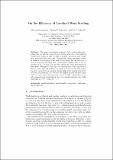| dc.contributor.author | Suksompong, Warut | |
| dc.contributor.author | Leiserson, Charles E | |
| dc.contributor.author | Schardl, Tao Benjamin | |
| dc.date.accessioned | 2019-01-28T18:06:08Z | |
| dc.date.available | 2019-01-28T18:06:08Z | |
| dc.date.issued | 2015-10 | |
| dc.date.submitted | 2015-10 | |
| dc.identifier.issn | 0020-0190 | |
| dc.identifier.uri | http://hdl.handle.net/1721.1/120140 | |
| dc.description.abstract | This paper investigates a variant of the work-stealing algorithm that we call the localized work-stealing algorithm. The intuition behind this variant is that because of locality, processors can benefit from working on their own work. Consequently, when a processor is free, it makes a steal attempt to get back its own work. We call this type of steal a steal-back. We show that the expected running time of the algorithm is T[subscript 1]/P + O(T[subscript ∞]P), and that under the “even distribution of free agents assumption”, the expected running time of the algorithm is T[subscript 1]/P + O(T[subscript ∞]lgP) . In addition, we obtain another running-time bound based on ratios between the sizes of serial tasks in the computation. If M denotes the maximum ratio between the largest and the smallest serial tasks of a processor after removing a total of O(P) serial tasks across all processors from consideration, then the expected running time of the algorithm is T[subscript 1]/ P+ O(T[subscript ∞]M). Keywords: Parallel algorithms; Multihreaded computation; Work stealing; Localization | en_US |
| dc.language.iso | en_US | |
| dc.publisher | Elsevier | en_US |
| dc.relation.isversionof | http://dx.doi.org/10.1016/j.ipl.2015.10.002 | en_US |
| dc.rights | Creative Commons Attribution-NonCommercial-NoDerivs License | en_US |
| dc.rights.uri | http://creativecommons.org/licenses/by-nc-nd/4.0/ | en_US |
| dc.source | Other univ. web domain | en_US |
| dc.title | On the efficiency of localized work stealing | en_US |
| dc.type | Article | en_US |
| dc.identifier.citation | Suksompong, Warut et al. “On the Efficiency of Localized Work Stealing.” Information Processing Letters 116, 2 (February 2016): 100–106 © 2015 Elsevier B.V. | en_US |
| dc.contributor.department | Massachusetts Institute of Technology. Computer Science and Artificial Intelligence Laboratory | en_US |
| dc.contributor.department | Massachusetts Institute of Technology. Department of Electrical Engineering and Computer Science | en_US |
| dc.contributor.mitauthor | Leiserson, Charles E | |
| dc.contributor.mitauthor | Schardl, Tao Benjamin | |
| dc.relation.journal | Information Processing Letters | en_US |
| dc.eprint.version | Author's final manuscript | en_US |
| dc.type.uri | http://purl.org/eprint/type/JournalArticle | en_US |
| eprint.status | http://purl.org/eprint/status/PeerReviewed | en_US |
| dspace.orderedauthors | Suksompong, Warut; Leiserson, Charles E.; Schardl, Tao B. | en_US |
| dspace.embargo.terms | N | en_US |
| dc.identifier.orcid | https://orcid.org/0000-0001-6386-5552 | |
| dc.identifier.orcid | https://orcid.org/0000-0003-0198-3283 | |
| mit.license | PUBLISHER_CC | en_US |
